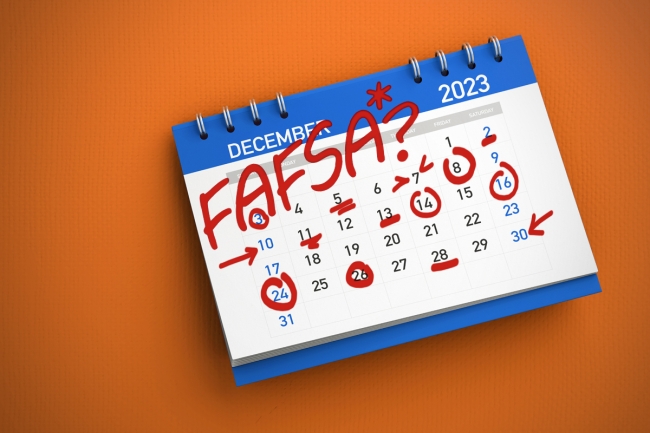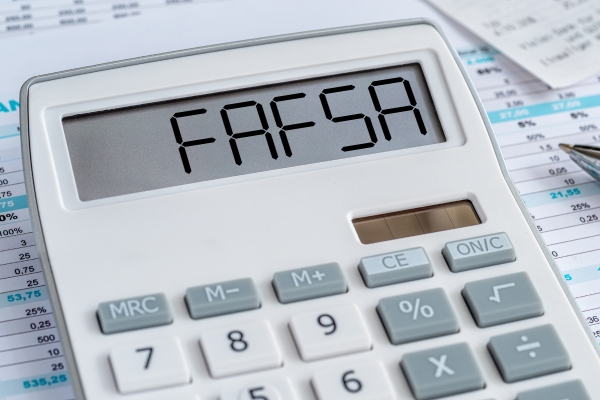You have /5 articles left.
Sign up for a free account or log in.

A FAFSA overhaul pushed the form’s launch back at least two months. With no concrete date set, colleges and families are waiting anxiously for a hectic financial aid application season to start.
Photo illustration by Justin Morrison/Inside Higher Ed | Getty Images
Helen Faith, the financial aid director at the University of Wisconsin at Madison, is usually busy this time of year with a familiar agenda: hosting informational sessions on financial aid applications for families, reviewing prospective students’ forms and generally revving up her office’s well-oiled machinery to start crunching numbers and spitting out student aid packages.
But with the Free Application for Federal Student Aid launch delayed by at least two months, Faith’s fall calendar is up in the air. And she’s not the only one.
The FAFSA is at the center of the college financial aid system, unlocking billions in federal, state and institutional aid for more than 18 million students annually. The federal government is overhauling the form as part of a project known as FAFSA Simplification, delaying this year’s opening from Oct. 1 to sometime in December.
Financial aid administrators, admissions officers, high school counselors and groups that assist students in filling out the form are all preparing for a hectic rollout, anticipating difficulties in advance and raising awareness among prospective students and families. But there’s only so much they can do.
“We can’t be 100 percent ready,” Faith said. “We need the application.”
The changes to the FAFSA have wide-reaching implications for higher education, as more students are expected to be eligible for the Pell Grant and receive more state and institutional aid. Advocates hope this “simplification” will make college more accessible for lower-income students.
For institutions, however, the changes could be expensive. If students’ federal financial aid goes up, colleges may have to increase institutional aid as well, and if it goes down, they may need to use their own funds to make up the difference—especially for current students, who will be immediately affected by the new calculations. But the money isn’t unlimited, so institutions have analyzed data and run models to estimate how much more aid they might have to put up.
“We’ve got a plan in place,” said Brad Barnett, financial aid director and associate vice president for access and enrollment management at James Madison University. “The question is, will the plan be accurate? This is where we’re going to have to be nimble as an institution. It could cost us more or less than what we’re anticipating based on what actually happens.”
For now, Barnett said there’s not much more the university can do to prepare. Officials are ready to get the new form and start processing students’ information—ideally, as soon as possible.
“It’s just a new learning curve for all of us who’ve been doing this for a very long time,” he said. “At this stage of the game, we’re as prepared as we can be until we see the full application and what it actually looks like and how it actually works.”
Pinning Down a Date
Jill Desjean, a senior policy analyst with the National Association of Student Financial Aid Administrators, said the form’s actual changes are a problem for later.
“Right now, we’re very much focused on the impact of the delay,” she said.
An Education Department spokesperson said in a statement that there’s no update on exactly when the new FAFSA will launch. Federal law requires the form to be available by Jan. 1, which is when the form was released until 2016, after which the launch date moved up to Oct. 1.
“As previously announced, it will launch in December, and our office of Federal Student Aid continues to work expeditiously on the 2024–25 FAFSA,” the statement said.
5 Things to Know About the New FAFSA
- The federal government will use a Student Aid Index instead of the current Expected Family Contribution to determine how much money a student should get.
- Eligibility for the Pell Grant will be based on household size and adjusted gross income, similar to the federal poverty guidelines.
- The current discount for families with more than one child in college is going away.
- The new aid-eligibility formula will take into account the net worth of family farms or small businesses, both of which have been exempt.
- Students whose families have an adjusted gross income of less than $60,000 won’t have to answer questions, making for an easier process.
The worry among admissions and financial aid professionals is that December could mean after Christmas—or even into the new year. At a panel on the new FAFSA at the annual National Association for College Admission Counseling conference last month, predictions about the actual launch date ranged from “4:59 on Friday, Dec. 22” to “Jan. 5.”
Some have also expressed uncertainty about whether the new form will even be operational when it launches or if technical issues will further delay the process. Those worries aren’t entirely unfounded: the Federal Student Aid office released a revised calculator two weeks ago so that students could get a sense of what they might expect to pay under the new system, but it went down within days of the launch. (Update: the calculator was re-released on Friday morning, after the publication of this article.)
At this point, financial aid administrators and others in the broader higher ed community say they’re feeling generally prepared, though anxious. All they need is a specific launch date and the actual form so they can start reviewing applications and preparing financial aid packages.
Jodi Vanden Berge, director of college planning and outreach at the EducationQuest Foundation, a Nebraska-based nonprofit that provides free college planning services to students and families, said most of her foundation’s work revolves around the FAFSA.
“We’ve got people calling, wanting to schedule an appointment, and we’re putting them off until after January because we don’t have an actual date in December to give them,” she said. “Right now not knowing for sure when that date is, it’s giving us a little angst about what that next couple of months looks like.”
Historically, more than half of high school seniors complete the FAFSA by Dec. 15, according to Kim Cook, executive director of the National College Attainment Network, a nonprofit membership organization focused on helping students prepare for and succeed in college.
“We know we have ground to make up,” Cook said. “Institutions are going to be under a lot of pressure to turn around aid offers quickly so that students can start to make their decisions among offers and among schools.”

A simplified version of the Free Application for Federal Student Aid and changes to the underlying methodology could open up the Pell Grant to more students.
Photo illustration by Justin Morrison/Inside Higher Ed | Getty Images
Edward Conroy, a senior adviser on New America’s education policy team, said financial aid offices will have all hands on deck this winter to deal with the changes. He used to work in the financial aid office at the University of California, Los Angeles, and said he wouldn't be surprised to get a call from his old employers asking if he has time to work on contract for them this year.
But until that happens, he's happy he's out of the game.
“I’m very glad I don’t work in financial aid this year,” he said. “January especially is going to be awful.”
‘Significant Disruption’ for Admissions
David Hawkins, NACAC’s chief education and policy officer, said regardless of how the delay affects institutions’ aid calculations, it would “cause significant disruption in the application cycle.”
Students are likely to find out what kind of aid they can expect later in the cycle than usual, he said, which could delay their decision-making significantly. Many institutions require commitments by May 1, giving applicants a much smaller window in which to make their college choice.
“While it may not amount to an existential crisis, the delay will without a doubt … further complicate an already uncertain yield landscape,” Hawkins wrote in an email.
Multiple panels at last month’s NACAC conference focused on the topic of FAFSA changes and delays. Brett Schraeder, managing director of financial aid optimization at the marketing and enrollment services provider EAB, who moderated the most popular of those sessions, called the rollout of the new form “a nightmare.”
High school counselors are feeling the pressure, too.
“It’s been a headache for everyone,” said Rob Lamb, director of college counseling at the Sage Ridge School outside of Reno, Nev. “And I’m worried financial aid offices are going to be so backlogged in the spring that students will have a much smaller decision-making window.”
Early-decision and early-action applicants will also be affected. A wave of institutions has deadlines in the next month, which will be the first affected by the delay. Historically, those schools aim to send students financial aid packages by the end of the year, which won’t be possible unless they create their own aid applications or use other methods such as the College Board’s CSS Profile, an alternative institutional tool for estimating student need.
For the private, highly selective institutions that already use the CSS Profile to determine institutional aid, the delay won’t have much of an impact. Miranda McCall, Duke University’s assistant vice provost and director of undergraduate financial support, said Duke will be able to offer aid packages early and stand by them “regardless of the FAFSA results.”
Forrest Stuart, vice president for enrollment management at Lafayette College, said the college “won’t be impacted at all” by the delay. But he added that institutions that do rely entirely on the FAFSA and also offer early-admission options will face a much thornier situation.
Wabash College, a private liberal arts college in Crawfordsville, Ind., with fewer than 1,000 students, is one such place. Alex DeLonis, associate dean for enrollment management and director of financial aid, said the college opted to create its own form this year to get a sense of its students’ financial needs early. A few other universities have done the same.
DeLonis said Wabash based its application on the drafts of the new FAFSA that the Education Department has been releasing in bursts over the course of the year. Wabash will use its form to calculate families’ aid packages by Dec. 1, and DeLonis said they will honor those offers even if the estimates differ from the federal government’s.
But families will still have to fill out the FAFSA when it opens.
“We’re concerned that it’s an added barrier,” he said. “That’s something we felt like we had to decide was the lesser of two evils here. But we think there’s a hunger for families to get the information as soon as possible, and it is an optional form.”
Journey to a Simpler FAFSA
Conroy with New America said more and earlier information will especially benefit low-income students who rely on federal aid calculations to decide not where they’re going to college, but whether to enroll at all.
“I’m not worried about students going to Carleton [College] or Duke [University] who have a dedicated school counselor with time to walk everyone through all these changes. It’s the students going to the Cal States or regional publics who need to know, ‘Can I afford to go?’” he said. “Having to wait longer to apply for FAFSA and figure that out might mean they just don’t.”
In lieu of a timely FAFSA form, many predicted that the CSS Profile would get a surge of new users, if only for this application cycle.
DeLonis said that while subscribing to the Profile didn’t make sense for Wabash, he imagined many colleges bit the bullet and shelled out to ensure they had some data to work with.
“Going back to my peers in the [Great Lakes College Association], many will be using the Profile for early decision,” he said. “Good business for [the Profile], I guess.”
But business isn’t exactly booming. A spokesperson for the College Board wrote in an email that the number of institutions using the Profile this year is “nearly the same” as last year—a little over 300—though the tool “does help colleges and universities begin developing preliminary financial aid offers ahead of the planned December FAFSA opening.”
Conroy said many of those Profile institutions are need-aware private colleges and universities, with ample resources and sophisticated admissions and financial aid operations to help them navigate a form that is both costly for institutions and infamously complicated to parse—both for financial aid officers and for families. Most institutions, he said, would rather deal with a contracted timeline than invest in the Profile for a year.
“Because there’s only a few hundred profile schools, you’ve got this much smaller pool of financial aid staff who understand the ins and outs and all of the complexities there,” Conroy said. “Unless your school has staff that have worked with the Profile at a previous job, I don’t see it being possible or worthwhile to change your entire process for one year.”
Schraeder put it more bluntly.
“[The CSS Profile] is a pain in the neck for everyone involved,” he said. “Most schools I’ve talked to have said, ‘We’ll just try to manage through this year and get to next year.’”





